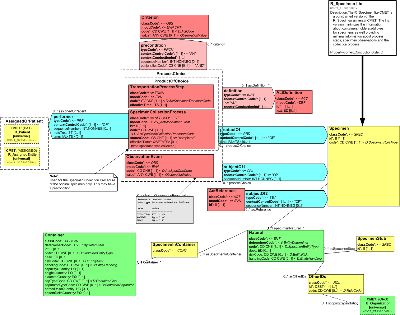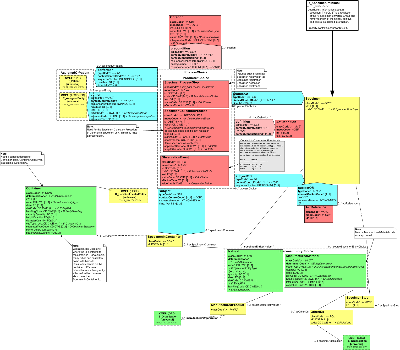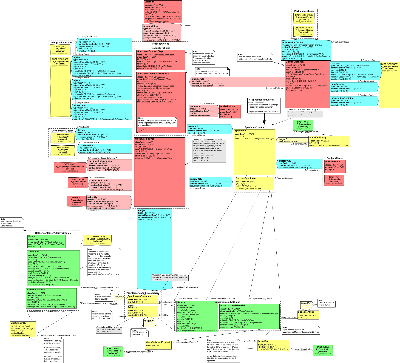|
||||||||||
|

| Parent: | Specimen (POSP_DM000000UV) |
The R_Specimen lite CMET is a constrained version of the R_Specimen universal CMET. The lite version minimizes the information about containers/holders/additives for specimens as well providing minimal information about process steps, specimen observations and the collection process. See the R_Specimen universal CMET for the detailed model walk-through.
| R_PatientUniversal | COCT_MT050000UV01 |
| R_AssignedEntityUniversal | COCT_MT090000UV01 |
| E_OrganizationUniversal | COCT_MT150000UV02 |
| R_Specimen lite | COCT_MT080200UV09 |

| Parent: | Specimen (POSP_DM000000UV) |
The R_Specimen minimal CMET is a constrained version of the R_Specimen universal CMET. The minimal version minimizes the information about containers/holders/additives for specimens, focusing mainly on information about the specimen itself. Information about a specimen, its container or both, includes information that aids in the analysis of a specimen and can be used by automation systems to interpolate settings required for automated analysis (e.g. container type, dilution factor.) Includes aliquot relationships, and container registration events. See the R_Specimen universal CMET for the detailed model walk-through.
| R_PatientUniversal | COCT_MT050000UV01 |
| R_LocationLocatedEntityUniversal | COCT_MT070000UV01 |
| R_AssignedEntityUniversal | COCT_MT090000UV01 |
| E_OrganizationUniversal | COCT_MT150000UV02 |
| E_OrganizationUniversal | COCT_MT150000UV02 |
| R_Specimen minimal | COCT_MT080100UV09 |

| Parent: | Specimen (POSP_DM000000UV) |
Model Overview For Specimen Universal
The Specimen CMET Refined Information Model (RMIM) captures information regarding a specimen and its container. Both the specimen and the source of the specimen are scoped by a specimenEntity which may be located in a container. The specimen itself may be the result of a process and can be acted on by any number of processes in order to handle both the specimen and the container.
The CMET has a central choice box (SpecimenChoice) that contains Specimen and DerivedSpecimen role classes. It should be noted that the CMET entry point is on the choice box, but has been constrained (via a text constraint) so that entry to the CMET is allowed only through the Specimen Role. This has been done because of tooling limitations which prevent the associations attached to the choice box from being properly inherited by the roles in the choice box if the entry point were directly attached to the Specimen role..
SpecimenChoice
Specimen: The Specimen role is played by an entity and scoped by the parent entity of the specimen. Attributes of the specimen role include an id and code describing the type of specimen role.
DerivedSpecimen: The DerivedSpecimen role is played by an entity and scoped by the parent entity. The parent of a derived specimen is always another specimen. Attributes of the specimen role include an id and code describing the type of specimen role.
Playing and Scoping Entities Associated With Specimen and DerivedSpecimen
The Specimen and DerivedSpecimen roles are played by the specimenEntityChoice. The Specimen role is scoped by the sourceSpecimenEntityChoice.
SpecimenEntityChoice: Choice of Natural (ENT) or ManufacturedMaterial (MMAT) entities).
Natural: An entity comprised of naturally occurring substance in the role of specimen.
ManufacturedMaterial: The ManufacturedMaterial entity class is used to document specimens which have been manufactured such as quality control specimens. The ManufacturedMaterial entity plays the role of a manufactured product, which is scoped by the E_Organization universal CMET representing the manufacturing organization.
Associations of SpecimenEntity Choice:
OtherIDsAn identifying relationship between the focal entity and a scoping organization. Note that this could be an identifier used by the primary scoping organization in a different context. The ids carried in this role are intended to be interoperable because they are associated with a specific Role class code. The role is played by the entity and scoped by the E_Organization universal CMET. A role that provides a non-specimen identifier for an entity in the role of specimen. Examples include medical record numbers, drivers license number, social security number, etc.
SpecimenStub: The SpecimenStub serves two purposes.When the associated entity is playing the role of specimen, then SpecimenStub conveys other specimen ids for the specimen. The SpecimenStub may be the target of an IDENT role link from an IdentifiedEntity role.
Additive: An additive mixed into the specimen, e.g., in an aliquot of citrate blood. Additive is a role scoped by the specimen entity and played by the AdditiveMaterial (MAT). AdditiveMaterial is a choice in the HolderContainerAdditiveChoice (see below). The Additive may be the target of an IDENT role link from an IdentifiedEntity role.
SpecimenInContainer: The SpecimenEntities play the role of content for a container. The SpecimenInContainer is scoped by the Container entity. Container is a choice in the HolderContainerAdditiveChoice (see below). The SpecimenInContainer may be the target of an IDENT role link from an IdentifiedEntity role. The player association from the specimen to the container role has a 0..* cardinality to support a single specimen in multiple containers. There are examples from veteranary medicine where a siongle specimen, for instance an animal cadaver, is contained in multiple containers. This is still treated as a single specimen.
HolderContainerAdditiveChoice: The HolderContainerAdditiveChoice is a choice of a Holder entity, Container entity or AdditiveMaterial entity.
Holder: Entity which contains either a container or another holder.
Container: The container entity contains the specimen and may also itself be the content of a holder, such as a vial containing a specimen that is placed in a carrier.
AdditiveMaterial: Additive mixed into the specimen, e.g., in an aliquot of citrate blood.
Role Associations of HolderContainerAdditiveChoice:
EntityInEntity: A Holder in holder, e.g,a carrier on a tray. A Container in holder,e.g., a specimen container in a carrier. A Material in Container. E.g. an anticoagulant in the container.
R_LocationLocatedEntity: The HolderContainerAdditiveChoice plays the role of a located entity via the R_LocationLocatedEntity universal CMET.
Role Links Associated With SpecimenChoice
TargetOf: The SpecimenChoice is the target of an IDENT role link. The associated IdentifiedEntity Role provides additional scoper information for the target Role.id. In this model the following roles are associated with IdentifiedEntity: Specimen, DerivedSpecimen, SpecimenStub, SpecimenInContainer and Additive. In each of these roles, the scoper of the role is not the orgnaization which assigned the role id, rather it is the source material from which the specimen, material, etc. is associated. The IdentifiedEntity role is associated with these roles via an IDENT role link to allow more information about the issuer of the Role.id to be provided. The 2.x equivalent to this is the concept of assigning authority.
Participations Associated with SpecimenChoice
SubjectOf3: The Specimen is subject of zero to many ActReferences or Annotations.
SubjectOf2: The specimen is the subject of zero to many ProcessChoice acts. See ProcessChoice below for a description of the acts included in ProcessChoice.
ProductOf: The Specimen is the product of zero to one SpecimenProcessSteps or SpecimenCollectionProcess. This identifies the specimen, via its role, that is the product of a process. This process may be any act from the ProductChoice. Where this is the original specimen, the SpecimenCollectionProcess will generally be the appropriate process but, where there is an aliquoting or other specimen treatment that results in a "new specimen," the SpecimenProcessStep is appropriate.
ProcessChoice: ProcessChoice contains the ProductChoice acts as well as an ObservationEvent act.
ProductChoice: A specimen may be the product of either a SpecimenProcessStep act or a SpecimenCollectionProcess.
SpecimenProcessStep: A SpecimenProcessStep is performed on a specimen and its container or holder. Typical process steps are Specimen Collection, Specimen Accession, Specimen Separation etc. The Process Step in EVN mood is intended to identify that the step has taken place but not to report any value or the outcome. For instance, when Cold Agglutinins are discovered in the specimen during the processing of a CBC test the specimen is placed in a 37 degree wash for two hours. This observation would record that this had been performed.
SpecimenCollectionProcess: SpecimenCollectionProcess documents the obtaining or planed obtaining of an original specimen from the subject of interest. Used for the Specimen Collection Procedure of the original specimen only. This may have a precondition.
ObservationEvent: An observation performed related to an entity in the role of specimen. Observations are actions performed in order to determine an answer or result value. Observation result values (Observation.value) include specific information about the observed object in this case a specimen.
ProcessChoice Act Relationships
Precondition: Associates specific criteria that apply prior to a particular Specimen process. The process choice for the specimen may have any number of Criterion Observations as a precondition, such as fasting before a glucose tolerance test. The Criterion is a precondition observation for the ProcessChoice.
SubjectOf4: The ProcessChoice may the subject of a ControlAct. These Control Acts communicate the trigger event and other "action" information regarding the associated act. This structure is useful for historical query responses and result communications. The ControlAct is modeled on the Control Act wrapper from Specification Infrastructure. See Trigger Event Control Act Infrastructure D-MIM for additional information regarding the control act.
Definition: The definition act relationship is used to associate a ProcessChoice with its ActDefinition (master file). The source act is an instance of the target definition act. The ActDefinition class represents the definition (master file) for the associated ProcessChoice. Typically this definition is drawn from the local service catalog.
SubjectOf5: The act my be the subject of zero to many Annotations. Annotations include any sort comments, special instructions, etc.
ControlVariable: The ControlVariable participation documents the order options associated with a ProcessChoice.
PertinentInformation: An ProcessChoice is associated with zero to many items of supporting clinical information that are pertinent to the event. The information is carried in the SupportingClinicalStatement CMET.
ProcessChoice Participation's
Performer: Identifies the performer of the ProcessChoice. This may be an assigned entity or a patient.
Author: The entity responsible for creating the ProcessChoice, details of which are carried in the AssignedEntity CMET.
Transcriber: Identifies the person/device transcribing the data, details of which are carried in the AssignedEntity CMET.
Verifier: Identifies one or more individuals who verify the content of the ProcessChoice, details of which are carried in the AssignedEntity CMET.
Device: A test kit that is participating in the process step as a device.
Consumable: Lab test kit or reagent that is taken up, is diminished, or disappears in the process step.
Subject: The SpecimenInContainer or Additive is subject of zero to many ProcessChoices.
| R_PatientUniversal | COCT_MT050000UV01 |
| R_LocationLocatedEntityUniversal | COCT_MT070000UV01 |
| R_AssignedEntityUniversal | COCT_MT090000UV01 |
| R_AssignedPersonUniversal | COCT_MT090100UV01 |
| R_AssignedPersonUniversal | COCT_MT090100UV01 |
| R_AssignedDeviceUniversal | COCT_MT090300UV01 |
| E_OrganizationUniversal | COCT_MT150000UV02 |
| E_OrganizationUniversal | COCT_MT150000UV02 |
| E_OrganizationUniversal | COCT_MT150000UV02 |
| A_OrderOptionsUniversal | COCT_MT210000UV02 |
| R_ReagentUniversal | COCT_MT250000UV03 |
| R_LabTestKitUniversal | COCT_MT430000UV09 |
| A_SupportingClinicalStatementUniversal | COCT_MT530000UV |
| A_AnnotationUniversal | COCT_MT590000UV |
| A_AnnotationUniversal | COCT_MT590000UV |
| R_Specimen universal | COCT_MT080000UV09 |
| Return to top of page |

